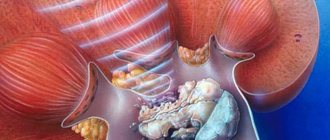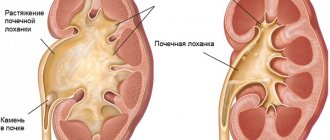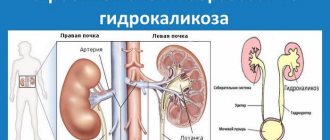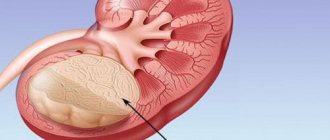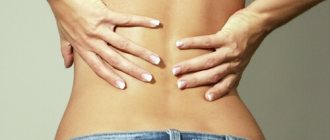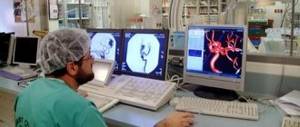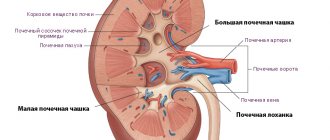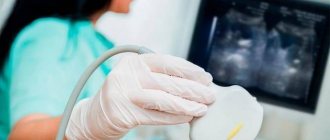Micronephrolithiasis is a pathological process in which “sand” or small stones (up to 6 mm in diameter) are found in the patient’s kidneys. Many experts do not distinguish pathology as a separate disease, but consider micronephrolithiasis to be a stage in the development of urolithiasis. In any case, the problem requires careful diagnosis and immediate treatment.
Lack of therapy leads to the progression of the pathology and the full development of urolithiasis. Over time, the disease can lead to inflammatory processes in the kidneys, for example, pyelonephritis, which poses a serious threat to the patient’s health. Don’t delay going to the doctor, take good care of your health, and follow the doctor’s recommendations flawlessly.
What is the disease?
Micronephrolithiasis of the kidneys is diagnosed in patients with impaired functional activity of the kidneys. In such patients, the presence of salt sediment is inevitably detected during microscopic examination of urine. As a result, the sediment turns into sand and then into rocks.
Patients experience painful urination. If the true cause is not identified in time, the stones will inevitably reach large sizes, and then treatment will include radical measures.
In fact, this disease does not have official recognition, that is, specialists simply diagnose the presence of stones or sand in the kidneys. We can say that renal micronephrolithiasis is the initial stage of urolithiasis.
The causes of the disease must be examined by a qualified specialist.
Prognosis and possible complications
The lack of treatment for micronephrolithiasis threatens the formation of urolithiasis and the course of inflammatory processes in the kidneys. Ultimately, the disease causes kidney failure and can lead to death.
Timely therapy and compliance with doctor’s instructions will help you avoid a sad fate. A negligent attitude towards health leads to physical and mental disorders, ruining not only the patient’s life, but all the patient’s relatives feel discomfort.
Causes
Micronephrolithiasis of the kidneys can be the result of the following reasons, namely:
- metabolic disorders (metabolism);
- hereditary predisposition;
- poor nutrition;
- infectious and inflammatory processes;
- urinary tract abnormalities;
- long-term use of calcium-containing medications, as well as vitamins C and D;
- endocrinological pathologies.
The main reason that provokes the formation of sand and kidney stones is tap water. Depending on the region, the composition of the water may differ. For example, if there is an excess amount of minerals in the water, this can have a detrimental effect on the health of residents.
Prognosis and prevention
With proper and timely treatment, the prognosis is usually favorable. The main preventive measures are nutritional control, monitoring the quantity and quality of water consumed, avoiding drinking alcohol, strong tea and coffee, and timely treatment of urinary tract diseases and associated pathologies.
It is known about the disease micronephrolithiasis of the kidneys that it is a pathology that may not be noticeable in the initial stages of development, but can lead to a more serious urolithiasis. Therefore, you should not neglect preventive examinations, which allow you to identify the disease in time and begin treatment.
The best treatment option is prevention; micronephrolithiasis is no exception. By adhering to simple rules, you will not only prevent the formation of pathology, but also improve your condition in general.
The most important criterion for effective kidney prevention is proper diet and control of a person’s lifestyle. Proper nutrition and elimination of unhealthy diets normalizes the internal functions of the body.
Let us note the following important factors for stimulating preventive cleansing of salt deposits:
- Constant monitoring of diet
- Drinking large amounts of water
- Avoid energy drinks and sugary water
- Avoid heavy physical activity
Symptoms
So, as already mentioned, timely help is the key to a speedy and successful recovery, but the problem is that identifying micronephrolithiasis in both kidneys is not so easy.
Painful urination can only bother the “owners” of the disease occasionally, that is, when removing accumulated sand.
In some cases, patients may feel pain only when the stones have already reached large sizes.
Pain when urinating is the main clinical sign of renal micronephrolithiasis
Another sign of the disease may be a decrease in the daily amount of urine excreted. Painful sensations can be localized in the abdomen and lower back. Much depends on where exactly the formed stone is located.
Microliths in the kidneys: causes, symptoms, diagnosis and treatment
Photo from bolyatpochki.ru
Microlithiasis is a disease characterized by microliths. It develops over a long time, and without treatment it can develop into kidney stones or renal colic.
Causes
Microliths are formed from salt grains that remain in the kidneys due to metabolic disorders. These form stones over time.
There can be many reasons:
- metabolic disorders, in particular water-salt imbalance;
- poor nutrition, namely insufficient fluid intake, abuse of meat, spicy, sour and salty foods;
- gastrointestinal diseases, for example, gastritis, ulcers;
- cholecystitis;
- pyelonephritis;
- chronic inflammatory diseases of the urinary tract;
- endocrine pathologies;
- hormonal disorders that lead to electrolyte imbalance and calcium withdrawal;
- deficiency of vitamins and microelements, hypercalcemia;
- adhesions, neoplasms in the urinary tract, which causes urine retention;
- hereditary predisposition;
- abnormalities in the structure of the urinary tract;
- surgical intervention on the organs of the urinary system.
In men, renal microcalculosis can occur due to prostate adenoma, which is why they are more likely to have microlithiasis.
Symptoms
Since the microlith is tiny, the size of a few grains of sand, there may be no symptoms. More often, a person learns about his problem when large stones form or he undergoes an ultrasound examination of the kidneys. In the latter case, the outcome is the most favorable, since unpleasant complications can be avoided.
Symptoms of renal microlithiasis:
- darkening of the urine, a change in its consistency, it becomes viscous, there is a sediment in the form of sand;
- increased urge to urinate;
- swelling of the legs;
- lethargy, chronic fatigue;
- nagging, aching or sharp pain in the lumbar region, lower abdomen or groin area;
- flatulence;
- increased blood pressure and body temperature.
As kidney microliths begin to increase, bloody discharge may appear in the urine. This occurs if the ureter is injured.
Single microliths in the kidneys that have reached a diameter of more than 4 mm, if released, can cause unbearable pain. At the same time, the urge to urinate becomes more frequent, and the process becomes painful.
The larger the microliths in diameter, the greater the pain.
The localization of pain depends on the location of micro stones. The microlith of the left kidney is manifested by pain on the left, the right - on the right. When both organs are affected, pain spreads along the entire lower back.
Left-sided microlithiasis is most difficult to detect. Symptoms appear only when the pebble grows to 3 mm in diameter.
Diagnostics
The correct diagnosis can only be made after an instrumental examination. During a visual examination and study of clinical manifestations, the doctor may have doubts, since microlith of the right kidney is similar in symptoms to appendicitis or liver failure.
Symptoms of microliths in the kidneys in women can be confused with inflammation of the appendages, as pain appears in the lower back and abdomen, and body temperature rises. However, with palpation it is possible to determine the exact source of pain.
Microlithiasis of both kidneys can be mistaken for back disease, since the pain is not constant and intensifies with bending, turning, and changing body position. However, after tapping, it becomes obvious that the problem is not in the spine.
At home, you can distinguish microliths of both kidneys from back diseases, for example, from osteochondrosis. You need to take an antispasmodic. If the pain goes away, then the kidney is to blame.
Laboratory diagnosis of renal micronephrolithiasis involves clinical and biochemical analysis of blood and urine. Based on the clinical results, an infectious-inflammatory process can be identified; as a rule, it is absent. Thanks to biochemistry, metabolic disorders are visible, there are deviations of the main indicators from the norm.
Excretory urography is important in the diagnosis of micronephrolithiasis of both kidneys. This is an x-ray examination using a contrast agent. The photographs show the location of microliths.
The second most important reliable method for identifying microliths is kidney ultrasound. The specialist will notice the most minor changes. It is possible to determine the size and location of micro stones with maximum accuracy.
Microliths in the CLS of both kidneys can be detected by ultrasound only if they are more than 6 mm in diameter, although this size is typical for full-fledged stones.
Treatment
Treatment of microliths in the kidneys is predominantly conservative, but it must be comprehensive. These are medications and diet.
Medicines
For treatment, drugs are used that remove sand and small stones and have a diuretic effect. These are Cyston, Prolit, Nephrolit.
If the formation of microliths is accompanied by an infectious-inflammatory process, then additional antibiotics are prescribed - Furagin, Furadonin, Norfloxacin.
To relieve pain, antispasmodics are used - No-shpa, Baralgin.
Folk remedies
Photo from hozyain.by
Treatment of microliths in the kidneys with folk remedies should be carried out under the supervision of a doctor, after the origin of the stone is known.
Cranberry decoction is useful. To prepare it you will need 1 tbsp. l. berries and sugar to taste. Pour 200 ml of boiling water over these ingredients and leave for 10 minutes. Drink 1 tbsp daily. for a month.
Rosehip infusion is effective for microlitas: 1 tbsp. l. berries need to be poured with 200 ml of boiling water. Drink like tea. Instead of rose hips, you can use corn silk or birch buds.
Watermelon, melon, and cucumbers have a diuretic effect. They should be included in your diet.
Diet
In the treatment of renal micronephrolithiasis, dietary nutrition is important, however, when creating a menu, it is important to take into account the type of microlithiasis. The diet is selected individually for a specific patient.
First of all, it is important to establish a drinking regime, drink up to 2 liters of liquid to wash away the sand. But you should not drink hard water; on the contrary, it promotes the formation of stones. It must be cleaned first.
More often, patients are prescribed a plant-dairy diet; animal products are harmful. The following foods should be excluded from the diet:
- hot spices, including horseradish and mustard;
- salt;
- foods with a high acid content - sorrel, spinach, citrus fruits;
- smoked meats;
- mushrooms, legumes, cauliflower;
- fatty meat, offal;
- cottage cheese, milk and other foods rich in calcium;
- chocolate;
- coffee, strong black tea.
With carbonates, you need to reduce the consumption of calcium-containing products, with urates, give up meat, offal and fish, with phosphates, you should not eat dairy products, fresh vegetables and fruits. If oxalates are detected, then you should stop eating potatoes, sorrel, spinach, chocolate and coffee. Read more about the oxalate diet→
Prevention
Prevention of microlithiasis is best done in the summer. It is useful to eat vegetables and fruits that have a diuretic effect. Do not forget about drinking plenty of water, drink up to 2 liters of clean water in the summer and about 1.5 liters in the autumn-winter period.
Birch sap is useful. It removes sand, but if large stones form, it can cause harm, causing renal colic.
It is also important to normalize metabolism and restore hormonal levels.
Microliths in the kidneys are difficult to detect, but easy to prevent. To prevent the formation of large stones, you should eat right.
Oksana Belokur, doctor, specially for Nefrologiya.pro
about identifying sand and microliths in the kidneys
List of sources:
- Clinical course of the disease and treatment tactics for patients with residual caliceal stones / Yu. G. Alyaev, E. V. Filosofova, L. M. Rapoport // 2008. – No. 2. - With. 58–63.
- Suleymanov S.I. Clinical medicine. 2007. – vol. 85, no. 1. - With. 21–27.
- Combined use of minimally invasive technologies in nephrolithiasis surgery / T. N. Nazarov, V. P. Aleksandrov // Surgery. 2007. – No. 12. - With. 43–44.
Source: https://nefrologiya.pro/pochki/kamni/mikrolity/
Diagnostics
Often, the pathological process is detected purely by chance during an ultrasound examination of the kidneys and urinary tract.
Patients may consult a doctor with complaints of severe pain in the side, lower back and abdomen. Such clinical symptoms may strongly resemble renal colic of low intensity.
If a urologist suspects renal micronephrolithiasis, then, of course, you cannot do without an ultrasound, as well as a general urine test. Microscopy of sediment in the presence of pathology reveals salts: amorphous urates, phosphates, uric acid crystals, calcifications, oxalates, etc.
Symptoms of manifestation
The first signs of micronephrolithiasis are changes in urinary function. No unpleasant sensations when urinating are typical for a healthy person. If pathology is present, emptying the bladder may cause mild pain. The characteristics of urine also change; with deviations, it changes color, and you can see an admixture of light suspension. Pain syndrome appears in the lower abdomen or in the lumbar region when the urinary tract is full, the patient drinks too much water, or parallel treatment with diuretics is used.
The main symptoms are not pronounced and therefore patients in most cases seek help from a specialist when the disease has already developed quite strongly and often renal micronephrolithiasis develops into more severe forms of the disease. At the first manifestations of the disease, you should immediately consult a doctor. The following symptoms are characteristic of this disease:
- Aching pain in the lumbar region, which radiates to the lower abdomen and groin area.
- Severe pain in the above areas when moving.
- Frequent urge to urinate, dark urine, traces of blood.
- Severe increase in body temperature and blood pressure.
- The appearance of frequent swelling.
- Weakness, deterioration of general condition.
To carry out diagnostic measures, the patient must submit a morning urine collection. If there are deviations in the analysis, an ultrasound examination of the genitourinary system is additionally prescribed, and X-ray images are also taken. These diagnostic procedures are sufficient to accurately determine or exclude renal micronephrolethiasis. Based on the tests, the attending physician will prescribe a course of treatment.
Treatment
Treatment of micronephrolithiasis includes the following tasks:
- at the first stage, the patient should be relieved of pain;
- the further stage is aimed at preventing the development of pain;
- The next task is to reduce the stones and also prevent their further development.
Treatment is carried out in two ways, namely:
- traditional methods;
- ethnoscience.
Before prescribing drug therapy, the doctor determines the cause of the formation of sand and stones
For example, if uric acid crystals appear in the urinary sediment due to calcium-containing drugs, then the first step is to simply stop these drugs.
Next, stimulants and restoratives are prescribed that will help normalize the functional activity of the kidneys.
Micronephrolithiasis is not treated with antibacterial drugs.
If the urinary tract is blocked, the patient is prescribed surgical intervention, which includes the following:
- crushing of stones;
- crushing stones by punctures;
- abdominal surgery is performed in more serious cases;
- endoscopic and laparoscopic surgery are innovative technologies used recently.
If we are talking about an attack of severe pain, then first of all, treatment comes down to the use of antispasmodics that will relieve muscle spasm. After pain relief, treatment should be aimed at preventing infectious and inflammatory complications. Depending on the composition of the stone, the doctor selects means that promote their removal.
Surgery is a last resort measure that is used for large stones that cannot be eliminated on their own.
What is renal micronephrolithiasis: etiology of the disease and methods of treating the pathological process
Micronephrolithiasis is a pathological process in which “sand” or small stones (up to 6 mm in diameter) are found in the patient’s kidneys. Many experts do not distinguish pathology as a separate disease, but consider micronephrolithiasis to be a stage in the development of urolithiasis. In any case, the problem requires careful diagnosis and immediate treatment.
Lack of therapy leads to the progression of the pathology and the full development of urolithiasis. Over time, the disease can lead to inflammatory processes in the kidneys, for example, pyelonephritis, which poses a serious threat to the patient’s health. Don’t delay going to the doctor, take good care of your health, and follow the doctor’s recommendations flawlessly.
articles:
What is it, etiology of the disease
Micronephrolithiasis develops against the background of the same unfavorable factors as urolithiasis. The formation of salt deposits in the kidneys and urinary tract of a person is based on metabolic disorders.
Metabolic processes in the body are influenced by many factors:
- genetic predisposition;
- unhealthy diet (eating large amounts of fatty, fried foods, lack of vegetables and cereals in the diet, consumption of sweets);
- the course of concomitant diseases of the urinary tract of an infectious and inflammatory nature;
- abnormal structure of the genitourinary system, which increases the risk of stagnation of urine and the appearance of various ailments;
- the patient has endocrine disorders. Women often suffer during pregnancy or menopause;
- uncontrolled intake of drugs containing potassium, vitamins D, C;
- ingestion of water saturated with heavy metals and other harmful substances (residents of African countries suffer from this problem);
- disturbance of water-salt balance against the background of constant dehydration.
All of the above factors negatively affect the human body, causing the deposition of salts in the kidneys. Over time, a small sediment turns into full-fledged stones, disrupting the process of formation, accumulation and excretion of urine from the patient’s body. Self-poisoning leads to serious consequences, including death.
What is adrenal incidentaloma and how to treat the disease? We have the answer!
A list and characteristics of effective medications for kidney inflammation can be seen in this article.
Symptoms
Micronephrolithiasis of the kidneys develops almost asymptomatically, which makes diagnosing the pathology difficult. In most cases, the disease is accidentally detected during an ultrasound. The patient experiences pain as sand passes through the urinary tract. Pain may also accompany the advancement of large stones.
Characteristic signs of pathology are:
- pain in the lumbar region;
- decrease in the amount of urine, sometimes urine changes color (becomes several shades lighter);
- pain may move to the abdominal area (it all depends on the location of the stones).
If unpleasant symptoms appear, even slight discomfort, contact a nephrologist. The doctor will carry out the necessary diagnostic procedures and help cope with the pathological process.
Diagnostics
The disease can be detected by performing an ultrasound of the urinary system. The patient may complain of pain in the abdomen or lower back, similar to renal colic, but of less intensity. Often, pathology is noticed during an ultrasound for a different reason.
To prescribe the correct treatment, a general urine test and a biochemical study of urine will be required. Such manipulations will allow us to determine the chemical composition of sand and stones and select appropriate therapy.
General rules and methods of treatment
Therapy for micronephrolithiasis is aimed at relieving unpleasant symptoms, eliminating the root cause of the pathology, removing stones and sand from the patient’s kidneys, and preventing relapses.
Drug therapy is used to eliminate discomfort and help remove formations.
The lion's share of treatment lies on the shoulders of the patient (following a diet and using folk remedies plays a huge role in recovery and the absence of relapses).
Drug therapy
Effective drugs:
- antispasmodics (relieve attacks of pain, relax muscles, facilitating the passage of sand or stones through the urinary canals);
- Antibacterial agents are used in severe cases when a kidney infection is suspected. The doctor chooses a specific drug, taking into account the patient’s condition and the causative agent of the infectious process;
- Depending on the chemical composition of the salts in the patient’s kidneys, the doctor selects medications to help remove them.
Folk remedies and recipes
The drugs are extremely popular, given the safety of the drugs and their effectiveness in the treatment of micronephrolithiasis:
- herbal decoction Natural plant mixtures have long been popular for kidney treatment. To make the potion, combine two parts of corn silk, the same number of birch leaves, and one part of burdock roots. Mix all ingredients and add boiling water in a 1:1 ratio. Infuse the product for one hour, then strain, drink 25 ml each time after meals;
- oats The product copes well with kidney problems. Pour boiling water over 100 grams of raw materials (1:1). After 12 hours, eat the porridge, adding a little honey and nuts;
- leaves, grape branches. Finely chop the chosen product, add a liter of water, and boil over heat for a quarter of an hour. Use the prepared medicinal decoction daily before meals for several weeks.
Do not use products that cause allergies or are not suitable for your type of disease. Discuss treatment with a specialist first.
Prognosis and possible complications
The lack of treatment for micronephrolithiasis threatens the formation of urolithiasis and the course of inflammatory processes in the kidneys. Ultimately, the disease causes kidney failure and can lead to death.
Timely therapy and compliance with doctor’s instructions will help you avoid a sad fate.
A negligent attitude towards health leads to physical and mental disorders, ruining not only the patient’s life, but all the patient’s relatives feel discomfort.
The best treatment option is prevention; micronephrolithiasis is no exception. By adhering to simple rules, you will not only prevent the formation of pathology, but also improve your condition in general.
Recommendations:
- analyze your diet. It should be rich in plant foods. Eating only meat products threatens to increase uric acid in the blood (protein is actively involved in the synthesis of this substance), which increases the chances of developing urolithiasis;
- Avoid eating large amounts of salt and spicy foods. Salty foods contribute to water retention in the body, the appearance of edema, and other unpleasant pathologies;
- Take multivitamin preparations only after a doctor's recommendation. Uncontrolled use of medications leads to hypervitaminosis and problems with metabolic processes in the body;
- Drinking plenty of water (at least two liters per day) will help normalize the water-salt balance. In the summer, it is recommended to lean on watermelons;
- replace store-bought herbal teas with homemade products (decoctions of chamomile, calendula, centaury);
- Don't forget about medical examinations. Regular visits to the doctor are the key to excellent health and well-being.
Micronephrolithiasis of the kidneys occurs in many patients. Even young people who do not monitor the condition of their body are at risk. Follow simple rules and consult a doctor if necessary. Compliance with preventive recommendations and maintaining a correct lifestyle plays an important role!
Source: https://vseopochkah.com/bolezni/mochekamennaya/mikronefrolitiaz.html
ethnoscience
Treatment using folk remedies is effective and reliable, but we should not forget that medicinal herbs and other raw materials of non-traditional methods can cause harm if used incorrectly. This is why it is important to consult a doctor before starting the treatment process.
Let's consider popular and proven traditional medicine recipes:
- grape. To prepare the medicine, we use grape branches as raw materials, which are harvested in the summer. The branches should be chopped and dried. For one glass of boiling water, one teaspoon of chopped grape branches is enough. The product must be infused for two hours. Drink the infusion throughout the day in three to four doses;
- herbal collection It is necessary to prepare a herbal mixture, for which you will need the following ingredients: corn silk, birch leaves, burdock roots, steelweed. All components should be thoroughly mixed and poured with boiling water. The solution is infused for one hour. Next, the resulting infusion is filtered and consumed after each meal, just one tablespoon;
- oats This remedy is an excellent kidney cleanser. It is necessary to pour boiling water over the grains with husks, place it all in a thermos and leave for twelve hours. The product should be filtered and then consumed for breakfast. To improve the taste, you can add a little sugar or honey.
The use of unconventional methods should be carefully monitored by a physician
Preventive actions
As already described, complications of micronephrolithiasis include urolithiasis, during which surgical intervention is used using the methods also presented above.
To avoid such troubles, you must follow the diet and the following recommendations:
- include a large amount of dairy products and plant foods in your diet;
- take vitamins A and D;
- If possible, avoid spicy and salty foods;
- consume more water, in compliance with the daily norm;
- in the summer, consume more fruits, especially watermelons, which normalize the water-salt balance in the body and prevent the deposition of salt residue in the urine;
- gradually change your taste preferences for regular tea with herbal kidney teas, which can be purchased at pharmacies.
Compliance with the presented rules will help to cope with the presented situation, and will also prevent the re-formation of sand and stones.
This will greatly simplify the treatment process, because now the person will not suffer from the disease, because all the substances that contribute to the growth of stones will be promptly removed from the body. It should be noted that the diet - giving up salty and spicy foods - is not a temporary phenomenon, but a way of life. Review your diet and give preference to plant-based foods. Play sports and give up bad habits.
